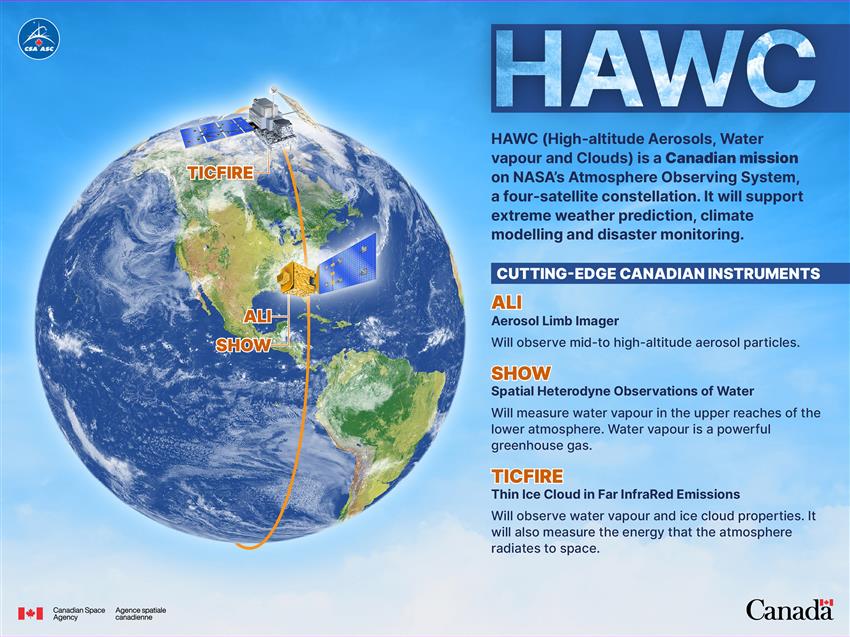HAWC mission: Clouds and aerosols to help predict climate change
- Mission status: In development
- Launch:
- Mission duration: 3 years with possibility to extend
HAWC (High-altitude Aerosols, Water vapour and Clouds) is a planned Canadian mission that will provide critical data to support severe and extreme weather prediction, climate modelling, air quality forecasting, and monitoring of disasters, such as volcanic eruptions, wildfires and extreme precipitation.
HAWC consists of three innovative Canadian instruments and a Canadian satellite. The HAWC mission will be part of the international NASA-led Atmosphere Observing System (AOS) mission.
A major component of NASA's Earth System Observatory, AOS is an international multi-satellite mission with many instruments that will measure aerosols, clouds and water vapour in the atmosphere and how they interact to impact Earth's weather, air quality and climate. The data collected by HAWC and AOS will improve our ability to predict near-term weather events, long-term climatic conditions and air quality.
What are aerosols?
Earth's atmosphere is full of tiny particles known as aerosols. Coming in different shapes, sizes, and chemical compositions, they are solid particles and liquid droplets suspended in the air. Common aerosols include smoke particles from fires, sea salt, dust, fine sand, air pollution, volcanic ash and pollen. Aerosols can be produced by natural events, like forest fires and volcanic eruptions. Humans also produce them through vehicle emissions, industrial processes and power plants that burn fossil fuels.
The effect of aerosols on climate change
Although tiny, aerosols have a big impact on our weather and climate. Some types of aerosols affect air quality and human health. Aerosols also affect cloud formation and precipitation such as rain and snow. Clouds and aerosols interact with light from the Sun and heat from Earth. This means that changing aerosols and clouds can either warm or cool the Earth depending on their types and locations. Improving our observations of aerosols and clouds is essential to a better understanding of the atmosphere and better predictions of climate change and extreme weather events.
Made-in-Canada technology
Canadian scientists and industry have unique expertise that allows Canada to significantly contribute to a large international mission such as AOS. For this mission, slated for launch in , Canada is contributing three cutting-edge instruments. Supported by the Canadian Space Agency, the following concept technologies have been designed and developed by Canadian universities:
- ALI (Aerosol Limb Imager) will observe mid-to high-altitude aerosol particles. It will allow scientists to understand aerosol sizes and densities, and their effects on clouds, reflected sunlight, and climate change.
- SHOW (Spatial Heterodyne Observations of Water) will measure water vapour in the upper reaches of the lower atmosphere. A powerful greenhouse gas, water vapour affects clouds and aerosols, and drives heating and cooling of the atmosphere.
- TICFIRE (Thin Ice Cloud in Far InfraRed Emissions) will observe water vapour and ice cloud properties. It will also measure the energy that the atmosphere radiates to space, providing better information on how the atmosphere cools. TICFIRE will provide the ability to monitor this "far infrared" radiation from space, which up until now has not been possible.
Made-in-Canada science
Over the past half century, Canadian scientists have been playing a leading role in understanding the make-up of the atmosphere by building and operating a number of successful space missions.
The HAWC mission will build on this expertise by bringing together universities from across Canada, Environment and Climate Change Canada, and National Research Council Canada. This collaboration will allow Canada to fully exploit the rich data set that both HAWC and AOS will provide.
Canadian university collaborators include:
- University of Saskatchewan
- Université du Québec à Montréal
- University of Toronto
- McGill University
- University of New Brunswick
- Université de Sherbrooke
- University of Waterloo
- Wilfrid Laurier University
- St. Francis Xavier University
- Saint Mary's University
- University of Victoria
- Western University
- Dalhousie University
- York University
The AOS
The AOS will study aerosol and cloud processes that drive extreme weather and climate change. It will collect measurements of aerosols, clouds, convection and precipitation using multiple instruments in various locations from Earth orbiting satellites and suborbital platforms.
Better climate projection for Canadians
The data gathered by HAWC as part of the AOS will allow Canadians to better anticipate and prepare for extreme weather events including storms, floods, droughts, and poor air quality conditions.
This information is crucial for projecting the impacts of climate change. It will help improve wildlife and habitat management. It will also allow communities, particularly those in the North and near water, to better develop and maintain their infrastructure.
Given it will be orbiting near the Arctic, HAWC will provide information on polar atmospheric conditions and how they affect weather patterns and climate conditions both in the North and the rest of Canada.
Better weather predictions and climate projections will help scientists, governments, and industry work together to find ways to adapt to climate change, protecting the health of Canadians and improving the resilience of our society.
Canada has developed expertise that allows it to participate in the future AOS mission led by NASA. This mission will provide vital data to improve long-term climate projections and short-term weather and air quality predictions. (Credit: CSA)
To learn more about the AOS, visit the mission's webpage: https://aos.gsfc.nasa.gov/.


